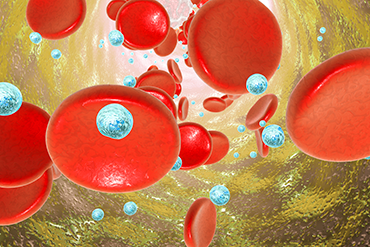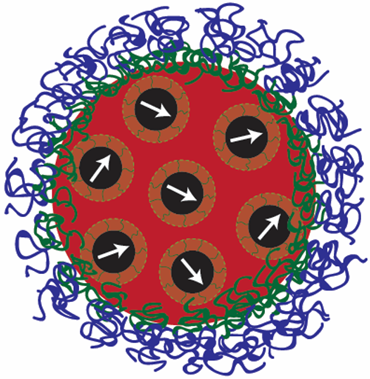Remote-controlled nanoparticles could fight cancer — gently
Sealing toxic drugs inside nanoparticles could reduce their harmful side effects

Chemotherapy can cause your hair to fall out and make you feel tired and sick. Delivering the chemo drugs inside nanoparticles could reduce these side effects by making sure the drug goes only to the cancer.
Steve Debenport/E+/Getty Images
Cancer drugs need to be powerfully toxic to kill tumor cells. But they also can kill healthy cells, sometimes with brutal side effects. Now, scientists have designed a way to seal cancer drugs inside tiny capsules so the drugs won’t harm the healthy cells while traveling through the bloodstream. They hold that medicine securely until they reach a tumor and a remote control “switch” finally triggers the drug’s release.
Smaller than bacteria, the capsules are called nanoparticles because their size is measured in nanometers. (A nanometer is equal to one billionth of a meter, or 3 billionths of a foot.) A magnetic field is the invisible force generated by a magnet.
Researchers use a magnetic field to work as that remote control switch. Focusing that field on the cancer site ensures that the medicine is released only where it’s needed.

“The drug is not toxic while it’s inside the particle,” explains Carlos Rinaldi. He’s a biomedical engineer at the University of Florida in Gainesville. He led the team that designed the remotely activated particles.
The nanoparticles don’t seek tumors out. They do, however, tend to collect at tumor sites. And here’s how. Tumors tend to grow so fast that the blood vessels inside them can’t keep up. This causes holes to form in the blood vessels. For a nano-package carrying the medicine, those leaky spots become a doorway from the bloodstream into the tumor. The nanoparticles slip in through those leaks, then accumulate in the tumor.
Nanoparticles also can pile up in unwanted places. One such unhelpful collection point is the liver. This organ acts as a filter, snagging poisons out of the blood. It will also net some nanoparticles. Those caught in the liver could damage that organ if they shed too much of an anti-cancer drug.
For many years, researchers have studied how to make nanoparticles that won’t drop their drug cargo at such unwanted sites. Sometimes they relied on a chemical trait of the tumor — or the enzymes it produces — to unlock the particles. But not all cancers have the same chemistry. So the medicine might still leak out to poison cells outside the tumor. The new innovation by Rinaldi’s team is the creation of a a nanoparticle that won’t release its medicine anywhere until it gets very warm. And that warming occurs when the particle is exposed to a magnetic field.
The team published its findings January 9 in ACS Applied Polymer Materials.
Hot idea
The nano-package contains two types of particles inside a thin wall, or membrane. Picture something like a gumball machine, with two types of gumballs inside. The first gumball is a nanoparticle made of iron oxide. This metal responds to magnetic fields. Think of a paper clip that jumps to meet a refrigerator magnet. These particles also react when zapped with a certain type of magnetic field. Here, instead of jumping, they warm up.
The second type of gumball is a polymer (PAHL-ih-mur). This type of molecule is made from long chains of the same building blocks. The researchers figured out how to lock this polymer onto a molecule of a cancer-fighting drug. They’re linked using a type of chemical bond that breaks when it gets hot.
Next, Rinaldi’s team wrapped each gumball pair in a water-friendly jacket. This allows the nanoparticles to travel through the blood, which is water-based. The coating also acts as a disguise. It hides the nanoparticles from the body’s immune system. Each two-“gumball” package measures about 100 nanometers (0.0000039 inch) across. For perspective, a red blood cell is about 70 times that size.

When exposed to a specific type of magnetic field, the iron-oxide “gumball” in each package heats up. That breaks the bonds holding the medicine inside and sends it flooding out into the tumor.
For this new treatment, Rinaldi and his colleagues use a special machine that restricts where the field contacts the body. They can target that field to the tumor site. Nanoparticles in the liver or any other healthy organ won’t be exposed to the magnetic field. And that means any particles in them won’t release the drug.
Because the drug will be released only at the tumor, patients now can take higher doses of toxic cancer drugs without poisoning healthy parts of the body.
Not yet ready for the clinic
Chemotherapy using the new particles is still a ways off. The current work is a “proof of principle,” Rinaldi says. That means that he and his team have not yet tested the system on living cells, much less in animals. In fact, they still haven’t packed their particles with real drugs yet. In place of a drug, the researchers attached a glowing fluorescent (Flor-ESS-ent) molecule to the iron-oxide “gumballs.” That made it easy to track where and when the chemical was released in response to the magnetic field.
It would be “a major advance,” he says, “if they can really guarantee that these particles do not release [a] drug without [a] magnetic field,” says Amit Joshi. He’s a biomedical engineer at the Medical College of Wisconsin in Milwaukee. He works on nanoparticles but was not involved in this study. However, he cautions, without animal testing, “we don’t know how stable it is.” Even if nanoparticles work well in the lab, there is no guarantee they would work equally well inside the body.

The new nanoparticles do have features that make them look promising for medicine, Joshi says. The U.S. Food and Drug Administration has already approved iron-oxide nanoparticles for use in the body, he points out. And the magnetic fields used to trigger drug release by the new particles can reach tumors deep inside the body without surgery, he explains. That should make their use easier on patients.
“This is really, I would argue, for us, a small step,” Rinaldi says. “There’s a lot of things we don’t understand very well.” But every small step brings the technology closer to real-world use. In the end, he concludes: “It’s an exciting field with a lot of potential applications.”
This is one in a series presenting news on technology and innovation, made possible with generous support from the Lemelson Foundation.







